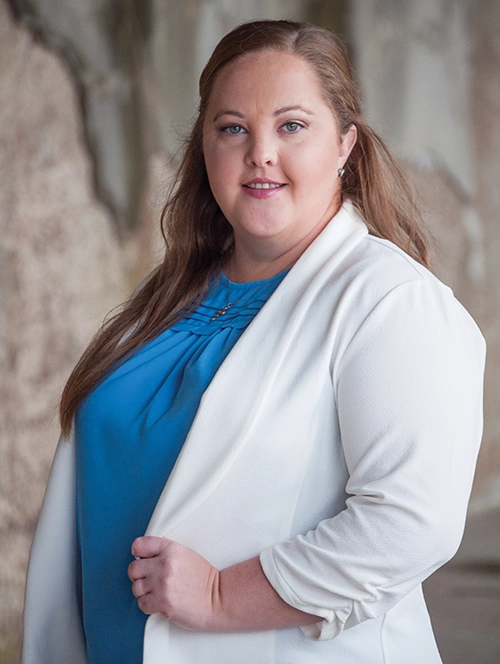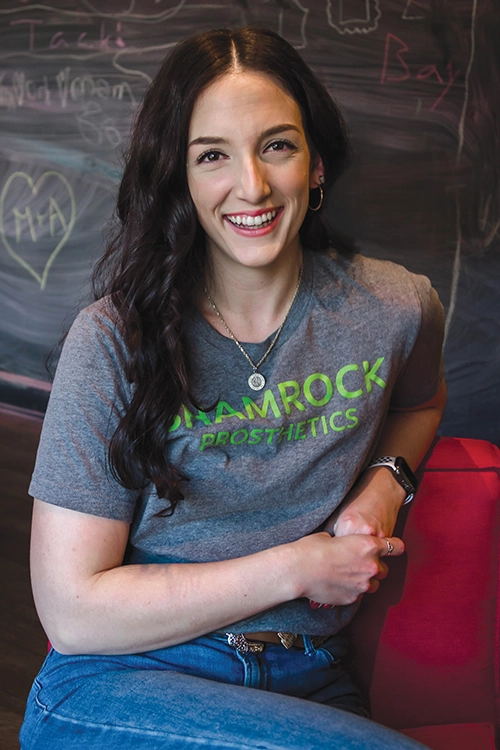Female prosthetists are gaining influence within the profession, and amputees stand to benefit in some important ways.
By Larry Borowsky
When Arlene Gillis completed her degree in orthotics and prosthetics, she was the only woman in her entire graduating class.
We don’t mean she was the only woman to graduate from her institution, Florida International University. Gillis was the only woman that year to earn an O&P degree in the whole country.
Almost every course Gillis took while earning her degree was taught by a male instructor. Men held most of the leadership positions in the O&P schools around the country and in the nation’s O&P professional organizations. From classrooms to clinics to coalitions, dudes ran the show and called the shots.
It sounds hopelessly old-fashioned, a time capsule from our grandparents’ era. But it wasn’t that long ago. Gillis graduated in 1994.
The contrast between her experience and that of today’s students could hardly be starker. Enrollment in O&P programs now skews heavily female, exceeding 80 percent in some of the top university programs. Many of those same programs are led by women. So are many US Department of Veterans Affairs prosthetic centers. It’s a completely different world from the one Gillis encountered less than 30 years ago.
And that means it’s a completely different world for amputees, too.
“The limb loss community will benefit from more women in O&P, bringing different perspectives to patient care,” says Gillis, who’s now president of the International Institute of Orthotics and Prosthetics and a board member of the American Orthotic and Prosthetic Association. “In general, I believe women think and problem-solve differently. I’m not saying that’s true in 100 percent of cases; I want to be very careful about that. But I do think that, over time, women are going to bring a more holistic approach to patient care, a different style of communication, and more collaboration with other healthcare professionals—including orthotists and prosthetists with one another.”
Those kinds of effects have been documented in other healthcare silos that have already witnessed the shift from an exclusively male workforce to a more balanced clinician population. The rising proportion of female practitioners in family medicine, surgery, oncology, and other healthcare sectors has brought significant change to patient care, as measured both by patients’ objective health outcomes and by their subjective satisfaction with their care.
No comparable studies have been conducted to gauge the impact women clinicians are making in amputee care; it’s still a little soon for that. But it’s not too soon to start asking questions and looking for clues. Women have made a significant impact in every area of healthcare they’ve migrated into. The same thing is bound to happen in the limb-care silo.
In fact, it’s already happening.
A More Diverse Pool of Practitioners
“O&P is a very intimate practice,” says Craig Towler, a bilateral leg amputee since 2016. “You need to be extremely vulnerable and work closely with your practitioner. Without a trusted and safe environment, this type of care can be very difficult. Any type of person-centered care needs a diversity of thought in order to provide the best care possible. Having more women in O&P adds new perspectives on care as well as lived experiences. Ultimately, it creates a net positive.”

“I’ve been an orthotics and prosthetics patient my whole life,” says Alicia Carver, a bilateral below-knee amputee who was born around the time Arlene Gillis began her practice. “Having a larger pool of prosthetists to choose from, and a more diverse pool, increases my chances of finding somebody who aligns with me.” She hastens to add: “I’ve been lucky to have really great male prosthetists who I felt were trying to help me as a person, not just trying to get a product delivered to me. I want to be sure I’m not coming across as saying anything negative about the care I’ve received from men.”
But as a lifelong consumer of O&P services, Carver knows as well as anyone that successful outcomes depend on successful relationships between patient and practitioner. The practitioner’s sex is only one component of that relationship, but in certain cases it can be a critical one.
“I like having prosthetists who are amputees themselves, because they can understand the way you’re feeling better than a person who’s never had that experience,” says Carver, an amputee advocate from Fort Wayne, Indiana. “Going through amputation as a woman, I might feel more comfortable talking about certain types of womanly issues that a male has never experienced.”
Carver cites clothing, skin care, sexuality, and pregnancy as some of subjects where the sex of the prosthetist makes a difference to her. She feels awkward even raising such aspects of limb loss with a male prosthetist, she says, leading her to tiptoe around them or censor herself entirely. “For those types of questions, I think a woman is definitely more approachable for me,” she says.
All these issues cut to the heart of perhaps the most intimate limb-loss issue of all: mental and emotional health. They influence a person’s self-image, self-confidence, and sense of identity. And if an amputee is struggling in those areas, it’s almost impossible to achieve good results with the limb itself. So it’s critical to trust that your practitioner can relate to where you’re coming from.
“It’s about feeling comfortable in your own skin again,” Carver explains. “For example, when you’re dealing with clothing and fashion, I want to feel like I’m putting myself back together again and presenting myself properly as a woman. But there are also practical questions: How do I don this garment? How do I properly adjust my prosthetics while I’m wearing this type of clothing? How does it affect skin issues, especially in delicate regions? You’re looking for a guide to answering those types of questions, and you might not feel comfortable raising them with a man.”
“I recently had a young female patient, 18 or 19 years old, who was going through some weight gain related to her amputation,” says Kelley Berk, a prosthetist at Shamrock Prosthetics in Athens, Georgia. “I noticed that she was really uncomfortable talking about her weight with my male counterpart, and when there was an opportunity with just me and her in the room, I was able to talk to her about it and tell her it’s okay, body changes are normal, and we’re going to help her. I was able to provide that tiny little bit more compassion that my male counterpart wouldn’t have been able to get with her.”

Like any relationships, those between patient and prosthetist change over time. Kate Ketelhohn, a college student with congenital upper- and lower-limb difference, had a close bond with her clinician throughout childhood. An amputee himself, he guided her through many complex limb issues and helped her build a strong sense of independence and self-confidence. But when, in early adolescence, Ketelhohn expressed a desire for prosthetic feet that could accommodate a pair of Converse high-top sneakers, he pooh-poohed the idea.
“He told me the only shoes I would ever wear my entire life were the six kinds that were displayed at the front of the clinic,” says Ketelhohn, who earned the prestigious Breece Fellowship this year from the National Association for the Advancement of Orthotics and Prosthetics. “That’s not what you want to hear when you’re a middle school girl. All my friends are talking with each other about what brand of shoes they get to wear, and I can’t even name the type of shoes I have. They’re just my wonderful prosthetic shoes.”
Ketelhohn remains grateful for this prosthetist’s care and expertise, but it stung when he treated her teenage footwear fashion needs like an annoyance. The rupture in the relationship widened from that point, and the disconnect began to affect how Ketelhohn felt about her limb difference. Eventually the family decided they needed to start over with a new prosthetist.
“The shoes were just one of many issues,” Ketelhohn says. “We just needed a different dynamic.”
They found it at a new clinic that had several women prosthetists on staff. Rather than scoffing at Ketelhohn’s hankering for high tops, these clinicians instantly related to it and worked enthusiastically at finding solutions.
Ketelhohn finally got to wear the Converse kicks she had long imagined herself in. She ended up with a range of shoe options that matched her peers’, helping her feel as if she fit in socially instead of sticking out for the wrong reasons.
“We actually had a conversation about what kind of shoes I liked and what different options were out there,” Ketelhohn says. “It’s not like we sat down with a catalog, but they basically told me I could get whatever shoes I wanted, within reason. Like, I couldn’t wear high heels. But they told me to give them one pair of shoes that I definitely wanted to wear, and they would make sure the foot fit with that one pair. And then beyond that, they recommended other brands of shoes that would also probably fit.”

“I gained a lot more pride in myself by being able to wear whatever I wanted,” she says. “Another thing they did was to make sure my prosthetic arm matched my feet. I was mostly wearing carbon fiber on my feet, so they would do the same color and same design of carbon fiber on my arm. That doesn’t sound like a big deal, but it made me feel very cohesive as a person, which made it more likely that I would wear them.”
The new practitioners also gave Ketelhohn constructive input on another issue her childhood prosthetist had waved aside: odor. When she complained that her prosthetic socks smelled funky, he said she should just wash them out every night. That didn’t really solve the problem, and moreover it obligated her and her mom to hand-wash the socks routinely, because her insurance only paid for two or three pairs.
Ketelhohn felt as if he was dismissing her concerns as the overwrought angst of a teen drama queen. But the women practitioners at her new clinic recognized it as a valid hygiene issue with health implications related to infection, skin health, and mobility. They immediately sent her home with some free sock samples so she could change more frequently. And they steered Ketelhohn and her mother toward a DIY solution involving a local seamstress and a skin-friendly material that can be purchased in bulk.
“I ended up with 12 pairs of socks,” Ketelhohn marvels. “I felt so spoiled!”
Any prosthetist, male or female, might have provided this type of responsive, patient-centered care. But as Towler points out, lived experience matters—and the limb-loss community benefits from a prosthetic profession that includes clinicians from the broadest possible range of backgrounds.
“I think every industry, including amputee care, benefits from a more balanced male-female workforce,” Towler says. “The more options for practitioners, the better.”
All On the Same Team
Towler has only worked with one practitioner, Angela Montgomery of Prosthetic and Orthotic Group, since he lost both legs in a 2016 accident. She happens to be a woman, and her lived experience doesn’t perfectly align with his. But she and Towler have a shared set of values, and that’s the key to their successful partnership.

Courtesy Craig Towler.
“Angela has an amazing capacity for empathy,” says Towler, now an organizer at the Center for People with Disabilities in Boulder, Colorado. “She has always worked hard to understand me as a person and how prosthetics fit into my life, and not the other way around. Her care has always been person-centered. This type of care is unique in the healthcare systems, with most of the care being very rigid, ignoring the person.”
It goes without saying that there are countless male prosthetists who have the same qualities and follow the same principles as Montgomery. But are these traits more common among women than among men?
Scholars have reached that conclusion with respect to practitioners in other healthcare silos. A 2017 paper published in the Journal of the American Medical Association concluded that “differences in practice patterns between male and female physicians may have important clinical implications for patient outcomes.” Conducted by a handful of scholars (all men) from Harvard’s school of public health, that study—which examined a huge sample of 1.5 million American patients ages 65 and over—concluded that “elderly hospitalized patients treated by female internists have lower mortality and readmissions compared with those cared for by male internists.”
The paper cites a sizeable body of peer-reviewed literature showing that female doctors are more likely than male doctors to follow clinical practice guidelines, deliver preventive care, and prescribe mental health counseling. There’s also evidence that women spend more time with patients than men, ask more questions, engage more often with family caregivers, and spend more time on psychosocial issues such as lifestyle, daily living, stress management, and relationships.
These conclusions sound like the type of outdated generalizations that can get a person into hot water on social media. But they are data-based findings, not lazy clichés or stereotypes. They don’t mean that every female practitioner is more attentive, caring, and effective than every male practitioner. But they do indicate broad tendencies that appear to be real.
Gillis has seen them in her own classrooms and training clinics.
“When the students are at patient evaluations, the women ask different questions than the men,” she says. “They’re looking more at the big picture instead of honing in on the biomechanical issues. For example, if somebody’s experiencing weight gain, they’re more likely to ask about what meds a patient is taking that might be affecting that. They’re more likely to ask if it could be related to thyroid. As I say, this is not true all the time, but it’s true in general.”
Gillis also believes women have a different style of advocating for amputees than men do. Again, speaking in generalities, she thinks female prosthetists tend to provide more in-depth detail when describing a patient’s needs to surgeons, pain specialists, physical therapists, and other clinicians. They might also be more persistent and have better follow-through, which can be particularly important when dealing with a reluctant insurer.
“Healthcare providers don’t communicate our patients’ stories well to insurance companies,” she says. “If a claim for one of my patients comes back denied, I’m picking up the phone and explaining, ‘Look, here’s why we coded it this way. Who do I need to talk to?’ I’m not settling for the frontline answer. I’m saying, ‘Get me to a decision-maker who can understand the nuances and override whatever the written policy is.’”
Although she’s forthright about the differences she sees between male and female styles of practice, Gillis keeps returning to the idea that it’s not an either/or situation. Everybody’s on the same team. And the team gets stronger when it becomes more versatile, more well-rounded, and more internally cooperative.
“O&P historically has been very competitive,” she says. “People don’t share their ideas because they don’t want their competitors to know what they’re doing. I think the more women we pump into the field, the more we’re going to collaborate and move together to the next frontier.”
Berk, who recently completed her O&P master’s degree at the Baylor College of Medicine, exemplifies that type of constructive collaboration. Entering the profession 29 years after Gillis, she graduated in a predominantly female class (17 women, five men). Her instructors and mentors included men and women, and she sees both men and women prosthetists at the cutting edge of research and innovation.
“One of my professors used to say, ‘There’s a thousand different ways to get to Cleveland,’” says Berk. “The point being that we’re all going to get to the same endpoint, but we’re going to take different paths there. I bring just as much to the table as my male colleagues, and they bring just as much to the table as I do. But maybe we do it in very different ways. We’ve added a couple more lanes to our freeways that bring us to Cleveland. We’re not cutting anyone off. We’re not rerouting anyone. We’re just adding more roads to the network.”




